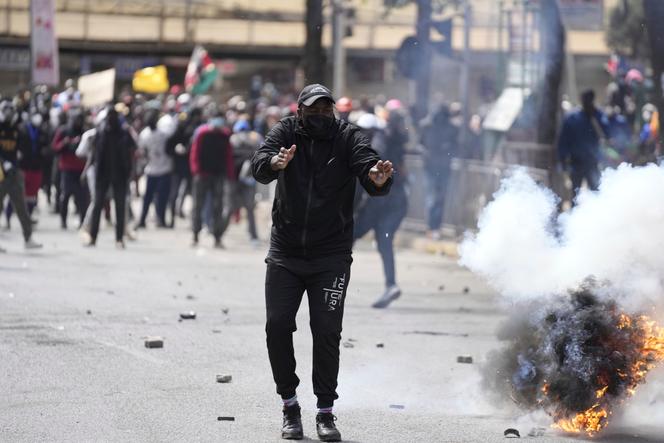


There are a handful of streets in the heart of Nairobi that symbolize power. The Kenyan capital's parliament, supreme court and governor's office are concentrated along these clean, wide thoroughfares. A modernist setting where civil servants and white-collar workers normally hurry along. On Tuesday, June 25, these streets were the scene of an unprecedented situation in Kenya's history: Protesting against the budget bill currently under discussion, demonstrators took over parliament.
Televisions and social media reported on the deployment of army vehicles in the city center, including water trucks extinguishing fires in some buildings, with tear gas and, in some cases, live ammunition firing in the background. On Tuesday evening, latest figures put the death toll at at least five, according to NGOs, while the Internet was cut off in most of Nairobi.
For Hiribae Wanyoike, a protester contacted by telephone, the rally was essentially "calm," and the watchword was not initially to enter parliament. "But people became angered at the police violence," this 29-year-old artist from Nairobi told Le Monde. "At one point, there was a lot of tear gas, I saw blood, bodies on the ground and people running towards parliament."
The protests were not confined to this symbolic location, affecting many major cities outside Nairobi. The national channel Citizen TV broadcast a scene of looting at a supermarket in the town of Nyeri (north of Nairobi), as well as footage of demonstrators throwing stones at an official building in Eldoret (north-west of the country). Located in the heart of the Rift Valley, Eldoret is known as a stronghold for President William Ruto.
Reforms carried out by the president, elected less than two years ago, are at the heart of these protests. The new draft budget law for 2024-2025 set the ball rolling. It added a series of taxes (16% VAT on bread, 2.5% annual tax on private vehicles in particular) to citizens' already tight budgets. Last year, the first budget bill presented by Ruto, a wealthy businessman who came from nothing and presented himself as the "president of the small resourceful people" during the 2022 election campaign, had introduced a series of new taxes, against a backdrop of very high inflation and the collapse of the Kenyan shilling. The government defended itself by insisting that its aim was to avoid defaulting on the country's growing debt.
But Kenyans, a third of whom live below the poverty line, are feeling the pinch from these austerity measures, while the government's lifestyle is seen as lavish. In the space of two years, the State House has been extensively renovated, the fleet of official cars renewed and the number of government posts increased. At the end of May, Ruto hired an expensive private jet for his delegation on a state trip to Washington.
"I think people have reached their limit, especially for young people," said researcher and essayist Nanjala Nyabola, author of "Digital Democracy, Analogue Politics: How the Internet Era is Transforming Politics in Kenya" (2018). Youth, and in particular the ultra-connected Gen Z, are at the heart of the current movement. This is unheard of in Kenya, where in recent decades demonstrations have traditionally been organized by political parties, often quick to pay participants from deprived neighborhoods to attend. On social media, the "Occupy Parliament" movement emerged in mid-June, organizing two initial demonstrations over the past eight days, featuring placards reading "Ruto must go."
"We've had a massive generational shift in how people receive, consume and distribute information. these young people have informed each other about the contents of the finance bill, have galvanized each other and mobilized each other. wasn't possible to do that if you were just depending on traditional media," added Nyabola. In her opinion, the movement is much broader than just Generation Z, but it is mathematically very visible in a country where, she reminded us, "60% of the population is under 35."
"These are kids who were educated, people who are very keenly aware of the issues that they're facing, and they're able to point out the injustices that they're seeing," she continued, pointing out that the budget bill has added to these underlying trends. "And the thing that compounds all of this is that the Ruto administration does not want to listen to people."
The extent of the anger towards symbols of the state, in a country marked by high levels of police brutality, is the other crucial lesson of this day of mobilization. "This is unprecedented," said Macharia Munene, historian and professor of international relations. "There have been demonstrations before but it's not the same scale. This is way beyond."
The demonstrators, noted the academic, have not experienced the decades of authoritarian rule (1980s and 1990s) and no longer have the same fear of the police as their elders. "They know the police is brutal. But they came up with strategies of diffusing the police. They even give the police water!" he says. "The demonstrators are not afraid. And that's what scares people in government because they don't know what to do."
In a military-sounding statement to the press on Tuesday evening, Ruto said that the "legitimate" popular expression of the demonstrators had been hijacked by a group of "criminal organizations." "Today's events mark a critical turning point in the way we respond to serious threats to our national security," said the president, promising to "provide a full, effective and expeditious response to today's treasonous events."
Translation of an original article published in French on lemonde.fr; the publisher may only be liable for the French version.
